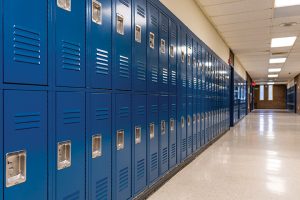A Nightmare Reality
As a uniquely American epidemic, schools across the nation maintain an urgency to keep their campuses safe with evolving safety protocols and active shooter drills.

For the entirety of this generation of students’ lifetimes, they have had to face a stark reality: the possibility of gun violence at school. In fact, firearms have been the leading cause of death among American children and teens for three years in a row, according to a September 2024 report by John Hopkins Center for Gun Violence Solutions.
The era of school shootings is often attributed to the April 20, 1999 Columbine tragedy, and unfortunately many misconceptions about these crimes have become the public standard. Over the years, students had had to grapple with active shooter drills that encompass the idea of a person—or their classmate—invading school grounds with a high-capacity firearm. While they hid under desks in the dark, administrators scoped the halls making sure doors were locked and windows were covered while teachers instructed their class to keep silent. These days, schools are aware that safety protocols require much more advance planning.
“Active shooter protocols have evolved significantly due to the increasing frequency of incidents and the lessons learned from past tragedies. Over time, response strategies have been fine-tuned to focus on swift action, improved coordination with law enforcement, enhanced communication tools, and better mental health support for affected students and staff. Schools are now more proactive in preventing and preparing for these incidents,” affirms Windermere Preparatory School Head of Security Ray Nappi.
“Orange County Public Schools (OCPS) has been improving school security to meet or exceed the requirements set forth in state statutes, Florida Department of Education’s Office of Safe Schools and the Florida Administrative Code. OCPS has various school safety procedures and protocols in place to provide for a secure environment and mitigate the impact of an actual emergency,” adds an OCPS spokesperson.
Some of these implements include randomized weapons screenings and detection systems, video surveillance installations, shatter-resistant film being applied to certain surfaces, the addition of perimeter fencing, and partnerships with local law enforcement to provide two school resource officers to each OCPS high school and intercoms to control all points of campus entry. OCPS has also utilized the SaferWatch-Alyssa’s Alert application so that employees can initiate a lockdown on both district-issued devices and personal devices.
“Annually, the district holds a two-day conference that trains school leaders on emergency management and safety issues. The event takes place every summer and includes training sessions for principals and assistant principals,” says the OCPS spokesperson. “The training sessions focus on preparing administrators for scenarios they might encounter at school, such as emergency response plans and procedures. The 2024 Preparedness Days focused on the reunification process during an emergency while last year’s event provided participants with an active assailant scenario.”
As more information and precautionary methods are developed, tragically through continued experiences, there is increased hope of an end in sight. Schools gain this knowledge by collaborating with other entities to come up with the newest, most innovative solutions. One such example of prevention that was previously inconceivable is artificial intelligence gun-detection software that allows school security cameras to scan for potential weapons and send an alert within seconds.
“We collaborate with local government agencies, law enforcement and other educational institutions to bolster our security measures. These partnerships are essential in designing comprehensive safety strategies and coordinated emergency responses,” says Nappi. “For example, we recently introduced the utilization of FortifyFL, a suspicious activity reporting app that allows students, parents and staff to instantly relay information about unsafe, dangerous or potentially harmful activities to both law enforcement and school officials. Once a tip is submitted, it is automatically routed to the appropriate law enforcement and school officials for immediate follow-up.”
In the shadow of the Columbine tragedy, society also remained wary of a “lone wolf” type of individual who had faced bullying and perhaps difficult home circumstances. Within the nearly-25 years since, it is now known that perpetrators come from all backgrounds and experiences, and violence can seem unpredictable at the onset. Mental illness and hardships in and out of school are certainly major factors, but there are also many children who suffer from these circumstances and do not go on to commit violence. Today—and even in the circumstance of the tragedy at Columbine—these threats are posted publicly online or discussed in private chatrooms.
The difference in 2024 is that a violent individual can become immersed in a culture that celebrates infamy within online communities of other individuals who will invigorate them to turn their thoughts into actions. These individuals will often also have an instigating incident that sends them into a crisis or suicidal ideation. With that in mind, while all speech may not be an intentional threat, schools and local law enforcement are at a point in which every instance has to be taken seriously.
Notable change happened with a tragedy much-too-close-to home in Parkland. The reaction from students who grew up with the looming threat of school violence and confronted it on their own campus was, to say the least, astonishing. The platform that was abruptly bestowed upon the survivors was utilized to make a difference in how these crimes are viewed, spoken about and handled.
Regardless of gun legislation or one’s stance on the issue, it is universally agreed that children with mental illness and a tendency for violent behavior should not have access to an assault rifle. This starts at home, as many perpetrators take guns from licensed-to-carry family members in order to commit an attack. In the new chapter of this horrific epidemic, parents of school shooters are beginning to face charges, such as the parents of the 2021 Oxford High School shooter in Michigan and, more recently, the father of the Apalachee High School shooter in Georgia.
One of the many long-term effects of this epidemic that is both slowly evolving and difficult to find solutions to without political conflict is apathy from younger generations. They have experienced a desensitization with so many shocking occurrences seemingly happening more frequently. This attitude is also exemplified by the aforementioned school protocol to take every potential threat seriously, in which youth may post or send a message online that they intended to be a (tasteless) joke. Kids make mistakes, especially online, but their unintentionally harmful activity might have harsh consequences. Furthermore, a false alarm only increases a sense of apathy, perhaps taking attention away from a real threat.
“What we’re seeing and hearing is a desensitized student not realizing the [severity of] comments, because what they’re hearing and saying on social media is not really taken serious. But when these comments are brought into a school setting, it elevates the seriousness of that comment—as simple or naive as it may be,” explains David Buckles, president of Foundation Academy. “As a school, you are forced to respond, you are forced to react, you are forced to bring in law enforcement because they are trained to assess, ‘Was that threat legitimate or was it just a young person being immature?’”
Again, not every child with mental illness has associated violent inclinations, but coping with this reality is why mental health and counseling services are key to improving a safe school environment. To take it a step further, incorporating a mental health curriculum can help create a safe environment in which students are given the courage to confide in school personnel if needed, as well as promote healthy coping mechanisms for stress, embarrassment and anger.
“I have two conference rooms in the brand-new facility we just built [with] an area that literally has a living room setting—couches, chairs and coffee tables—so that we can take a tough conversation off of a conference table and put it into a more relaxed situation for our staff and for a family. Because it may not be anything serious, but it may be the student’s acting up, it may be they’re failing,” continues Buckles. “We have had to analyze the triggers that set people off and what can we do to eliminate as many of those as possible.”
One would think that it is easy to dissociate from this rapidly occurring, nightmare scenario for which coverage for every tragedy is overshadowed by the next—especially with no concrete solution in sight. Students who lived with the fear of being shot at school are now parents who fear for their own children at school. Students, parents and school staff alike are refusing to accept the precedent, exchanging it for new solutions and in hopes of a different future.






